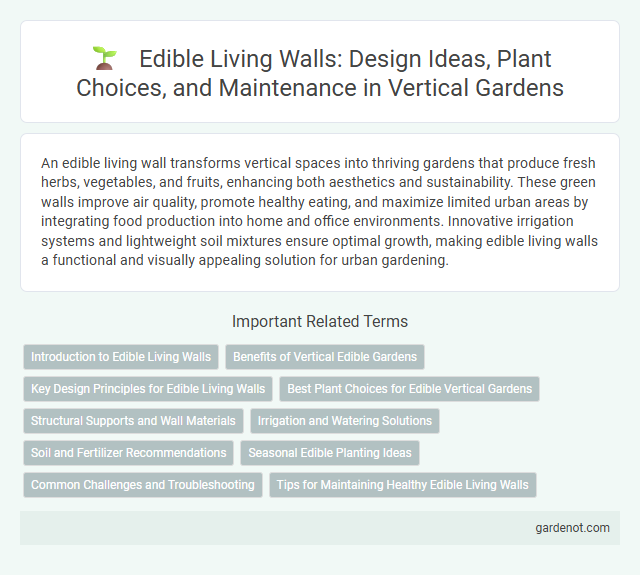An edible living wall transforms vertical spaces into thriving gardens that produce fresh herbs, vegetables, and fruits, enhancing both aesthetics and sustainability. These green walls improve air quality, promote healthy eating, and maximize limited urban areas by integrating food production into home and office environments. Innovative irrigation systems and lightweight soil mixtures ensure optimal growth, making edible living walls a functional and visually appealing solution for urban gardening.
Introduction to Edible Living Walls
Edible living walls transform vertical surfaces into vibrant, productive gardens by integrating herbs, vegetables, and fruits into living wall systems. These walls optimize space in urban environments while enhancing air quality and providing fresh, homegrown produce. Sustainable irrigation and nutrient delivery techniques support plant health and maximize yield within compact designs.
Benefits of Vertical Edible Gardens
Vertical edible gardens maximize urban space by enabling the cultivation of fresh herbs, vegetables, and fruits in limited areas. These living walls improve air quality, reduce heat absorption, and promote biodiversity by attracting pollinators and beneficial insects. Incorporating edible plants into vertical gardens supports sustainable food production and enhances aesthetic appeal while providing year-round access to nutritious, homegrown produce.
Key Design Principles for Edible Living Walls
Key design principles for edible living walls emphasize selecting plant species suited to the local climate and available sunlight to ensure optimal growth and productivity. Incorporating efficient irrigation systems and high-quality growing mediums supports healthy root development and nutrient absorption. Structural stability and accessibility for harvesting are crucial for maintaining the wall's durability and functionality over time.
Best Plant Choices for Edible Vertical Gardens
Herbs like basil, mint, and thyme thrive in edible living walls due to their compact growth and aromatic qualities. Leafy greens such as lettuce, spinach, and kale offer high yields and rapid growth cycles, making them ideal for vertical garden systems. Strawberry plants and cherry tomatoes can also flourish in these setups, providing fresh fruits while optimizing space and maximizing vertical surface use.
Structural Supports and Wall Materials
Edible living walls require robust structural supports such as galvanized steel frames or treated wood to securely hold the weight of soil and plants while withstanding outdoor conditions. Wall materials like moisture-resistant backboards, including PVC or marine-grade plywood, prevent water damage and promote healthy root growth in vertical gardens. Proper integration of support systems and durable materials ensures stability and longevity for edible plant installations on vertical surfaces.
Irrigation and Watering Solutions
Edible living walls require efficient irrigation systems to maintain optimal moisture levels for plant growth and yield. Drip irrigation and automated watering solutions deliver precise water amounts directly to the root zones, minimizing waste and preventing overwatering. Integrating moisture sensors ensures timely watering, promoting healthy edible plants and sustainable water use.
Soil and Fertilizer Recommendations
Edible living walls thrive on nutrient-rich, well-draining soil blends tailored for vertical gardening to ensure optimal root aeration and moisture retention. Incorporate organic fertilizers rich in nitrogen, phosphorus, and potassium to support vigorous growth and enhance the flavor profile of herbs and vegetables. Regular applications of balanced, slow-release fertilizers along with compost teas promote sustained nutrient availability and healthy microbial activity in the soil.
Seasonal Edible Planting Ideas
Seasonal edible living walls transform outdoor spaces by incorporating plants like kale and Swiss chard in winter, vibrant strawberries and lettuce during spring, and sun-loving tomatoes and basil in summer for a continuous harvest. Utilizing herbs such as thyme, rosemary, and mint throughout the year ensures flavor diversity and easy access to fresh ingredients. Integrating these seasonal edible plants maximizes growth productivity while enhancing visual appeal and sustainability in urban gardening.
Common Challenges and Troubleshooting
Edible living walls often face challenges such as inconsistent irrigation, pest infestations, and nutrient deficiencies, which can hinder plant growth and yield. Proper selection of drought-tolerant, pest-resistant plant species and implementation of automated watering systems help mitigate water stress and maintain plant health. Regular monitoring for pests and soil testing enable early detection of issues, ensuring timely troubleshooting to optimize productivity and sustainability.
Tips for Maintaining Healthy Edible Living Walls
Regular watering systems tailored to the specific needs of edible plants ensure consistent moisture without overwatering, which is crucial for healthy growth in edible living walls. Using high-quality, well-draining soil enriched with organic compost supports nutrient availability and root health, promoting robust plant development. Monitoring for pests and diseases through natural methods like neem oil or introducing beneficial insects helps maintain the health and productivity of edible vertical gardens.
Edible living wall Infographic

 gardenot.com
gardenot.com